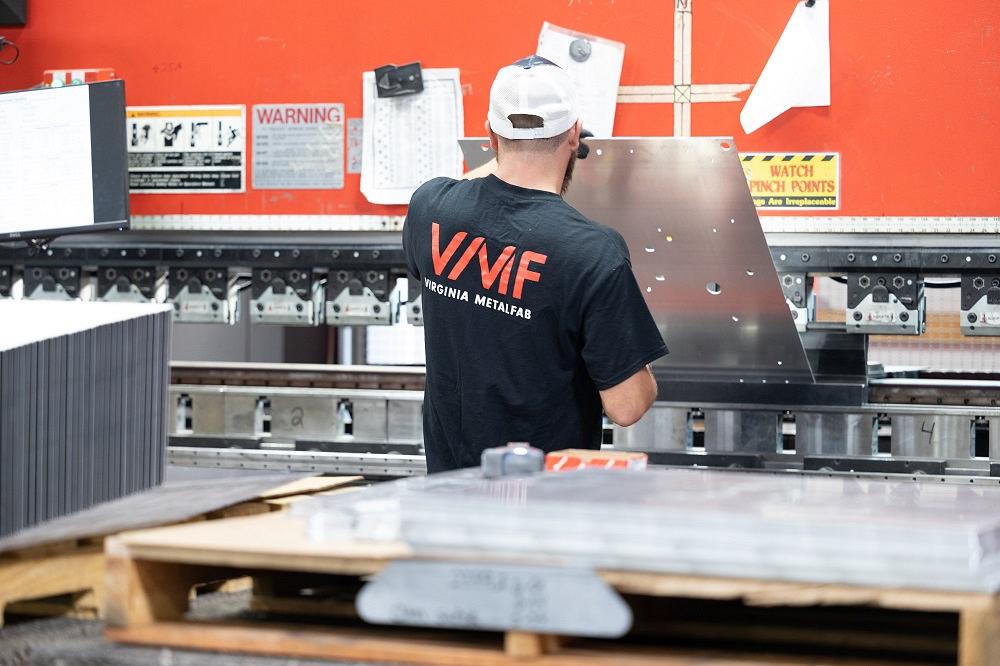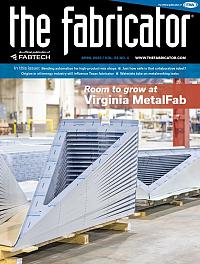Senior Editor
- FMA
- The Fabricator
- FABTECH
- Canadian Metalworking
Categories
- Additive Manufacturing
- Aluminum Welding
- Arc Welding
- Assembly and Joining
- Automation and Robotics
- Bending and Forming
- Consumables
- Cutting and Weld Prep
- Electric Vehicles
- En Español
- Finishing
- Hydroforming
- Laser Cutting
- Laser Welding
- Machining
- Manufacturing Software
- Materials Handling
- Metals/Materials
- Oxyfuel Cutting
- Plasma Cutting
- Power Tools
- Punching and Other Holemaking
- Roll Forming
- Safety
- Sawing
- Shearing
- Shop Management
- Testing and Measuring
- Tube and Pipe Fabrication
- Tube and Pipe Production
- Waterjet Cutting
Industry Directory
Webcasts
Podcasts
FAB 40
Advertise
Subscribe
Account Login
Search
How one manufacturing company is reshaping a Virginia community
The move to a larger metal fabrication facility spurs transformation at Virginia MetalFab
- By Tim Heston
- April 17, 2023
- Article
- Shop Management
When I walked into the hamlet of Appomattox Court House, now a National Historic Park bordering the modern-day town of Appomattox, Va., I toured the McLean House, where in 1865 the Confederate Army of Northern Virginia surrendered to federal forces. I saw a recreation of the table where Robert E. Lee put pen to paper, signaling the end of the Civil War and the beginning of the greatest period of transition in American history.
I said as much to my tour guide, adding that I was in town on business, visiting the newly opened Virginia MetalFab (VMF), a precision metal fabricator that had moved into the old Thomasville Furniture factory less than a mile away from the park entrance. She smiled broadly and promptly told me to say hi to Ron Martin, VMF’s CEO, and to thank everyone there.
“I’ve never been a celebrity, but I’m a celebrity here.”
That was Martin, speaking in his office in an 860,000-sq.-ft. facility that used to house one of the largest employers in the area. Out of 9,000 residents of rural Appomattox County, more than 1,000 worked at Thomasville Furniture.
Martin added that he never met my tour guide, but he’s also been all over local media. “Just the other day, someone stopped me in Walmart. He said, ‘I really appreciate what you’re doing. Keep up the work, and we’re all praying for you.’ He then kept walking. I had no idea who the guy was. And that happens every day.”
That’s saying something for a Yankee. The soft-spoken CEO from southeast Pennsylvania (and an Eagles banner to prove it, hung adjacent to sheet loading and unloading automation near the AMADA punch) is today leading an enterprise through the greatest transition in its history, from small job shop to major contract fabricator and stand-out employer supporting the Appomattox community.
As we walked from the office to the shop, Martin conceded that the transition, still ongoing, hasn’t been easy. But he also told me that VMF has what many fabricators lack. He opened the door and gestured to a collection of lasers, punches, brakes, and other equipment, all grouped in one corner of the plant. All this faced a vast, empty expanse.
Martin chuckled quietly. “We’ve got a little room to grow.”
A Fabricator in Horse Country
VMF’s story begins with what is now a small part of its overall business: horse stall fabrication and assembly. With its rolling hills leading south to the Blue Ridge, central Virginia is horse country. Those horses need barns, and in 2000 one of Martin’s friends began building them in central Virginia. He wasn’t happy with available doors and stalls, so in 2001 he launched StallWorks LLC and began designing and building his own.
A year later, Martin moved down from Pennsylvania to help. The two grew the business gradually until 2008, when Martin bought out his partner. At that point, all seemed smooth-sailing and the future seemed bright—until that September, when the market crashed and the economy fell apart.
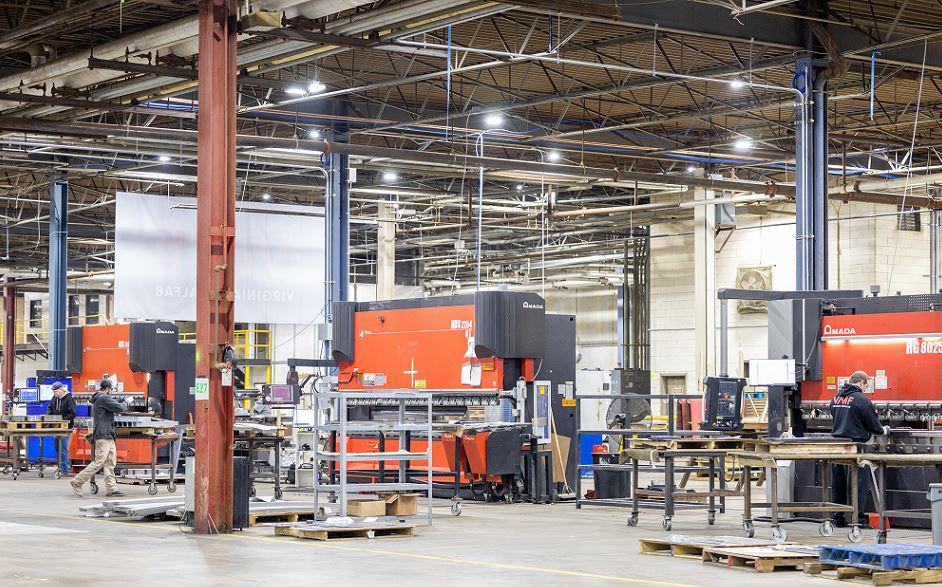
VMF’s press brake department, complete with jobs staged for production. In the previous facility, operators searched through overloaded shelves for the right job. The new plant has ample space, and everything is staged within adjacent kanban squares. If the job isn’t there, it isn’t ready. Virginia MetalFab
As Martin recalled, “I remember watching television and thinking, ‘I’m not real smart, but I’m pretty sure this isn’t good.’
The horse industry is largely discretionary spending, with some people taking out second mortgages [to support their equine hobby]. By 2009, things started to get really, really bad. And at that point, we were still outsourcing our fabrication work.”
Even worse, about a quarter of the stall fabrication jobs were custom, and Martin found he was spending much of his time driving back and forth to suppliers, requesting rework, and bending over backward to get all the parts needed for a door and stall system.
“So, we brought an old sheet-dragger [non-flying-optic] laser cutter and an old press brake, and we began teaching ourselves how to fabricate. We had never run such equipment before, and we really didn’t have a clue what we were doing. We just bootstrapped our way through.”
The operation gradually began selling laser cutting work to those who needed it, and by 2010 Martin formalized the contract work by launching VMF as a division of StallWorks. At the time, the entire organization (and the whole economy, for that matter) was still recovering from hard times. Work wasn’t plentiful.
“I realized all this was a bit like farming,” Martin recalled. “You need patience. We’re planting the seeds here, and we just needed to keep doing the right thing and deliver on promises.”
Before long, VMF’s first big order came in the door, worth all of $65,000. Martin was elated at first, then terrified. “I soon realized that I needed to buy $15,000 worth of material to get the job going. I didn’t know the customer real well.”
He picked up the phone, called the customer, and danced around the subject a bit, telling him he wanted to be able to deliver, avoid hiccups, and launch the project on schedule. “He then stopped me. ‘Ron, what do you need?’ I said, ‘I really would like to have a deposit.’ He said, ‘Ron, you send me the order details and I’ll wire you $30,000 today. Does that sound OK?’”
It was very much OK. Ron laughed telling the story, shaking his head, raising his eyebrows. “That was the beginning of a long crawl out of a deep hole.”
Over the next few years, VMF made its first big transition, from startup job shop to precision sheet metal fabricator. With that transition came new AMADA equipment—including a turret punch with in-process tapping and automated loading and unloading, a 2-kW fiber laser with sheet load/unload automation, and a collection of press brakes with precision-ground tools.

(From left) VMF’s management team: Ron Nicholson, production manager; Angie Patterson, sales manager; Ron Martin, CEO/owner; Brian Morris, general manager; and Rusty Elliot, manager of VMF’s new preproduction department. Virginia MetalFab
Contemplative Walks
For years, Martin commuted by the old Thomasville Furniture plant every workday. He saw it shutter in 2011 and the ensuing economic devastation throughout Appomattox County. “It’s difficult to walk around the community and not run into somebody who worked here, or at least know someone who did. Everyone seems to have a connection to this place. When the furniture production stopped, it really hurt this community. These were good-paying jobs.”
Martin also saw the community reel in 2014 when a Chinese company promised to move into the plant and create more than 300 jobs to build catalytic converters. Gov. Terry McAuliffe even posed for photos holding a large check signifying $1.4 million in grant money from the Virginia Economic Development Partnership. As it turned out, the company wasn’t properly vetted, accusations flew, taxpayer money was lost, and the entire deal fell apart.
Throughout all this, Martin kept commuting past the abandoned plant, watching the grass and weeds grow. The outside walls, at one point gleaming white, became grayer and grimier by the year. On his way home, Martin would sometimes park his truck and walk around the property. “It was dark, cold, wet. Still, I’d just walk around, and I really got to know the building quite well. I would think, ‘Someday, I would just love to move in here. Right now, it’s just such an eyesore. It could really be such a bright spot in this community.’”
At the time, Martin and his team were experiencing growing pains of their own. VMF had moved twice into larger facilities, the latest one being about 35,000 sq. ft., which soon became not nearly enough. Operators spent too long looking for parts shoved away on racks. Part flow faltered, yet at the time the operation was relatively small, so people could muscle jobs through. The shop built a reputation for stellar on-time delivery, which in turn led to more equipment and software investment and, ultimately, more opportunity.
One opportunity came from a company looking to source the bodies of wood-chip-hauling trucks. VMF had helped the company develop the prototype of the chip boxes that mounted onto the truck chassis. In 2019, the customer approached VMF and asked for more—not just prototype, but full-scale production, with workpieces up to 16 ft. long. Already sourcing some fabrication work to a fab shop in North Carolina, the customer was looking for another supplier.
“They were happy with their current fabricator, but that shop only wanted to grow so big,” Martin said. “They weren’t looking to cut ties; they just needed another partner to ramp up production. So, I said, ‘Look, I’ve got the potential for more space to take on this work.’”
That “more space” was the old Thomasville Furniture plant.
Discussions continued into early 2020, until the world changed. “When COVID hit, the whole thing imploded, and no one was quite sure what was going to happen,” Martin said. “Talks finally resumed in 2021, and by the beginning of 2022, I thought, ‘If we’re going to do something, let’s do it.’ We engaged with the [Thomasville factory] building owners, and a year later, here we are.”
Tear Down Those Walls
A lot happened in that year. The furniture factory was far from move-in ready. The place was abandoned, derelict, and gutted. After some negotiating, the owners put a new membrane on the building, including a new roof. They filled in pits in the floor with concrete. Everything had to be brought up to code, including the electrical and sprinkler systems. “There wasn’t a lot of vision as to what not to touch for the next company to move in here,” Martin said. “Everything was in rough shape.”
Next came determining the shop layout and—as is so common with brownfield development—knocking down walls. Traditional manufacturing has been all about departmentalizing, and the plant’s walls reflected this. The original layout had a wall that created a narrow, 30-ft.-wide band of factory space spanning the entire front of the building. VMF tore down about half of it to make room for its two fiber lasers—its original AMADA 2 kW for thin material and a new Eagle 20 kW for cutting thin and thick plate. The remaining narrow hall houses the company’s StallWorks assembly cells.

In December 2022, Virginia MetalFab (VMF) moved into the long-vacated Thomasville Furniture factory in Appomattox, Va. The entire building is 860,000 sq. ft., and VMF leases 230,000 sq. ft. Virginia MetalFab
Starting at the laser and punches, work flows in a zig-zag pattern, past the AMADA brakes, through welding, powder coating, finishing, and kitting—all next to what’s probably an envious site for many fab shop owners, especially after several years of record growth since the pandemic: a vast, empty expanse, all reserved for future work. Within it, VMF eventually hopes to build customer- or product-family-dedicated cells, each designed around certain jobs.
Lessons in Layout
In designing the layout, VMF leaders worked with a consultant who gave some valuable advice. In the previous plant, employees spent a lot of time searching—a classic waste identified by lean manufacturing—usually for parts stuffed into corners and onto shelves.
Aside from a few shelves for raw stock, the main area of VMF’s current plant has minimal shelving. Most work is laid out in front of each work center, providing an immediate visual cue of any bottleneck. When an operator receives an order on his tablet or laptop via ECI JobBOSS (the shop is largely paperless, using work-ticket job identifiers on pallets), he or she sees the work right there—no need to go searching on some far-off shelf.
Those visual bottleneck cues helped, especially when it came to its expanded powder coating operation. The previous shop had just one booth and one oven. The current plant layout has multiple ovens and paint booths that coat everything from small pieces hung densely in racks to large panels and even thick plate.
Such wide-ranging coating capability is one of VMF’s key selling points, but it also presents serious part flow challenges. “To be honest, we didn’t think about this before getting the 20-kW laser,” said Brian Morris, general manager, pointing to a sheet metal piece staged next to a welded assembly of thick plate. “You can bake that sheet metal part in 15 minutes. For that part [with thick plate], it will take an hour or more to get up to bake temperature. So, we were bottlenecked in this area, because it took forever for the oven to heat up.”
To account for the disparate bake times, the coating department now has three ovens, one used for drying after washing and pretreatment, two for the baking cycle. “And we can use the dry oven to bake as well,” Morris said. “So now, if we’ve got a bunch of thicker parts, we can fire up that third oven to bake, to keep things flowing through.”
Adjacent to the powder coating department and final products staging area is an unusual site: space for a flatbed truck to pull into the building to either unload raw stock or pick up finished parts and assemblies. Shipping and receiving occur inside, protected from the elements.
“I’ll admit, we battled over a lot of this stuff,” Martin recalled. “My team asked, ‘Are we really going to tie up 15,000 sq. ft. of the building just for trucks to drive through it? Isn’t that a waste of real estate?’ Well, maybe. But then you need to take everything outside, and there’s no room out there either. It could be raining or snowing. Do we want to expose uncoated mild steel parts to the elements?”
This goes back to lean thinking and defining what adds value. A problem in packaging and shipping causes the worst kind of rework. Scrapping a piece in packaging and shipping (the final process) effectively scraps all that value-adding work that occurred upstream. Sure, most operations don’t have the luxury of space, but VMF now does, so why not use it?
As Martin recalled, “I told people, ‘I hear you. I might be wrong about this, but at the end of the day, I make the call, and I don’t want to give up on this one. We’re going to do this.’”
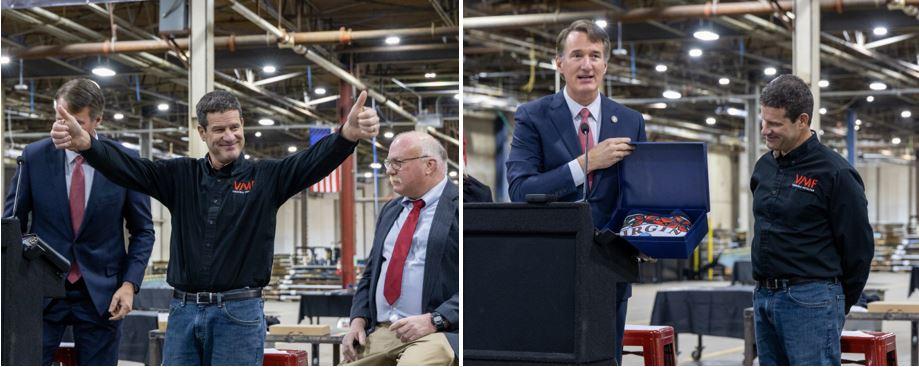
Ron Martin, VMF’s CEO, after a speech made at an open house the fabricator held in late December. At right, Virginia Gov. Glenn Youngkin presents Martin with the state flag. Virginia MetalFab
Growth and Growing Pains
Such interaction between front-line employees, the management team, and Martin helped VMF navigate through its growth spurts. In 2015, the entire organization employed just about a dozen people; in 2019, its headcount had grown to 40. Today, just four years later, VMF employs about 85 people. Sales growth has been just as impressive. In 2021, the shop made $5.6 million; in 2022, it was $11.5 million.
That said, Martin is not one to sugarcoat reality. “It’s not that 2022 wasn’t a good year. It was a great year. It was just a hard year. I’m glad it’s over. Numbers-wise, we were successful, but we’ve got to work on our processes. We’re working to get our mojo back.”
VMF’s growth path reflects that of many custom fabricators. They grow to about $10 million in annual revenue by bending over backward and putting in the hours to get jobs through the plant and out the door. Then, as work becomes complex and quantities grow, unexpected splashes have serious ripple effects. This can happen at shops that don’t move to a new facility during a post-pandemic rebound when every resource is stretched. When VMF moved to its present location in late 2022, it lost more than six weeks of production.
To rectify matters, VMF began to identify waste, especially in quoting and order processing. “You can do all the continuous improvement on the floor you want, but if you’re sending out orders incorrectly, you’ll still end up getting things wrong.”
VMF created its first preproduction department earlier this year. (According to Martin, this was inspired in part by content in The FABRICATOR magazine.) Too often, drawings sent to the floor didn’t have the information operators needed to move the job forward. Through JobBOSS, operators accessed virtual job travelers with links to various documents. Going paperless helped maintain a single source of truth—no more issues with multiple printouts and part revisions floating throughout the office and plant floor.
Still, sometimes the drawing files had broken links, and operators would waste time walking back and forth to the office to rectify matters. Sometimes it was a matter of just reestablishing the link; other times, those in the office had to reach out to the customer for clarification. Such mishaps for one-time orders is one thing, but having the same miscommunication occur for repeat work, time and time again, is quite another. As Martin put it, “It’s enough to drive you crazy.”
All this was the impetus for VMF’s preproduction process. The team acts as a liaison between sales, quoting, and the shop floor. They check drawings and all the embedded links, check for basic manufacturability concerns, and ensure everything is as it should be. They also perform post-mortems for completed work, comparing actual to the estimated costs, identifying what did and didn’t work, and feeding that information back to the organization.
“Their input really gives value to the sales team,” Morris said, adding that their analysis helps pinpoint strengths, weaknesses, and paths to future growth.
That growth includes a tube laser and an autonomous welding robot, both slated to be installed later this year. The welding automation, from Path Robotics, will be an autonomous system that’s able to “look” at the workpiece in front of it, compare it to the welding information in the 3D CAD file, and commence welding.
Beyond this, the team is already considering how its forthcoming tube laser (from BLM) could transform how they approach certain work, including the jobs that started it all—framing for horse stalls. StallWorks LLC was spun off into a separate company several years ago. Still under the same ownership, StallWorks orders (which today comprise about 15% of overall revenue) are sent to VMF like any other order, just with a dedicated assembly cell. The self-fixturing tubes cut by the tube laser could streamline that cell greatly, along with a host of other work in VMF’s product mix.

Plate cut with VMF’s 20-kW laser is staged before powder coating. Strategic use of three ovens for drying and baking help balance the flow for processing both thin and thick material.
Big Building, Bigger Transition
Martin described all this during a walk back from the shop floor, out the door, under an awning, and to a separate office building a few dozen feet away from the main plant floor. The design isn’t unique for a large manufacturing plant. That separate office building helped maintain a quiet executive suite.
Still, that separation and, in truth, the immensity of the place overall have created a bit of a culture shock. After all, many in the fabrication business relish life in the small shop, where the front office is just a few steps away from where the lasers cut and punches punch. Now at VMF, the walk to the office isn’t so short. As Martin said, “People have told me, ‘You mean I’ve got to walk all the way up here?’
“Now, we’ve got people coming onto the floor who are young. That’s a good thing, but that’s also a bad thing. They don’t come with bad habits, and they’re curious. But they also don’t come with years of industry knowledge behind them. So, how can we engage folks, encourage them to make suggestions?
“Culturally, we’ve had to navigate through a lot of change moving here, and no one likes change. It’s not the mom-and-pop shop it used to be. It can’t be. Employing 85 people is totally different from employing 10. We’ve got to be different. The bottom line is, we’re working to get people excited about what they’re doing.”
Part of that is the technology investment. Another part is keeping open lines of communication between the customer, the office, and the shop. At this writing, for instance, VMF is stepping up its communication with major customers, developing better forecasts (a challenge for everyone during the COVID-recovery supply chain chaos), and ensuring it can maintain available capacity and delivery reliability.
When it comes to culture at VMF, processes and procedures within the company comprise just half the equation; the other half involves connecting with people and, ultimately, changing lives, both within the shop and throughout Appomattox County.
“If all we do is make metal parts and make money,” Martin said, “I personally don’t find that terribly inspiring. But to get out and make a difference, that’s what gets me up every morning. That’s what makes it all worth it.”
VMF works with local charities, food kitchens, and of course provides opportunities for employment—but the fabricator goes beyond that. Martin recalled how, during COVID, an employee’s wife lost her day job while going through nursing school. She had just one semester left. So, VMF paid for her to finish nursing school so she could get back to work.
Later this year, VMF hopes to partner with local schools, including Appomattox High School, which is developing a tech center. Students will make actual parts for VMF (and get paid to do so) and learn the realities of production work in fabrication. Some also will delve into design.
“Everything looks right in design software, but then you get the assembly into the real world and things don’t fit perfectly,” Martin said. “So, we plan to have [students] design parts. They’ll see them being cut and formed, and they can see what worked and what didn’t. We won’t tell them whether their idea will work or not. They’ll see it being made and know if it worked or if it didn’t. That’s how they’ll learn.”
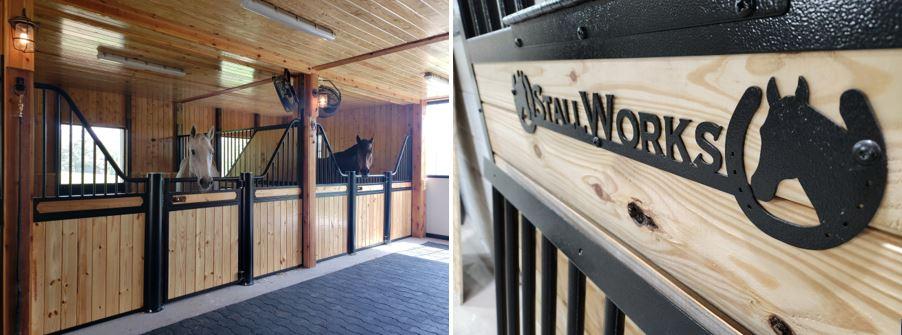
VMF’s roots are in the equine industry. The fabricator still manufactures horse stalls, but today its equine product lines, made under the StallWorks brand, make up just 15% of overall revenue. Virginia MetalFab
That experience reflects how Martin himself, a one-time horse-barn builder and horse stall assembler, learned the precision metal fabrication business. There’s likely a reason why a volunteer tour guide at Appomattox Court House knew all about VMF, its people, and how they’ve changed the greater Appomattox area.
“I wanted us to have an eternal impact on the community,” Martin said. “I’m a man of faith. We need to make money, but it can’t be all about that. We need to have a greater purpose—to show God’s loving kindness to our community. It’s that simple.”
About the Author

Tim Heston
2135 Point Blvd
Elgin, IL 60123
815-381-1314
Tim Heston, The Fabricator's senior editor, has covered the metal fabrication industry since 1998, starting his career at the American Welding Society's Welding Journal. Since then he has covered the full range of metal fabrication processes, from stamping, bending, and cutting to grinding and polishing. He joined The Fabricator's staff in October 2007.
subscribe now

The Fabricator is North America's leading magazine for the metal forming and fabricating industry. The magazine delivers the news, technical articles, and case histories that enable fabricators to do their jobs more efficiently. The Fabricator has served the industry since 1970.
start your free subscription- Stay connected from anywhere

Easily access valuable industry resources now with full access to the digital edition of The Fabricator.

Easily access valuable industry resources now with full access to the digital edition of The Welder.

Easily access valuable industry resources now with full access to the digital edition of The Tube and Pipe Journal.
- Podcasting
- Podcast:
- The Fabricator Podcast
- Published:
- 04/16/2024
- Running Time:
- 63:29
In this episode of The Fabricator Podcast, Caleb Chamberlain, co-founder and CEO of OSH Cut, discusses his company’s...
- Trending Articles
Tips for creating sheet metal tubes with perforations

Are two heads better than one in fiber laser cutting?

Supporting the metal fabricating industry through FMA

JM Steel triples capacity for solar energy projects at Pennsylvania facility

Omco Solar opens second Alabama manufacturing facility

- Industry Events
16th Annual Safety Conference
- April 30 - May 1, 2024
- Elgin,
Pipe and Tube Conference
- May 21 - 22, 2024
- Omaha, NE
World-Class Roll Forming Workshop
- June 5 - 6, 2024
- Louisville, KY
Advanced Laser Application Workshop
- June 25 - 27, 2024
- Novi, MI
























